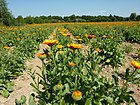Note: This is a project under development. The articles on this wiki are just being initiated and broadly incomplete. You can Help creating new pages.
Difference between revisions of "Calendula officinalis - Pot Marigold"
(→Common names) |
(→Photo Gallery) |
||
| Line 48: | Line 48: | ||
==Photo Gallery== | ==Photo Gallery== | ||
<gallery class="left" caption="" widths="140px" heights="140px"> | <gallery class="left" caption="" widths="140px" heights="140px"> | ||
| − | + | ||
| − | + | ||
| − | + | ||
| + | |||
| + | Calendula officinalis 2004-02-21.jpg | ||
| + | |||
| + | |||
| + | Calendula Officinalis (Real Jardin Botanico, Madrid) (4657015473).jpg | ||
| + | |||
| + | |||
| + | 2009-06-28 (17) Marigold, Ringelblume.JPG | ||
| + | |||
| + | |||
| + | Calendula Feld Weleda.jpg | ||
| + | |||
| + | |||
| + | Calendula officinalis 0068.jpg | ||
| + | |||
| + | |||
| + | Calendula officinalis 1a.JPG | ||
| + | |||
| + | |||
| + | 20160814Calendula officinalis.jpg | ||
| + | |||
</gallery> | </gallery> | ||
Revision as of 16:28, 26 April 2018
Calendula, is a genus of about 15–20 species of annual and perennial herbaceous plants in the daisy family Asteraceae that are often known as marigolds.:They are native to southwestern Asia, western Europe, Macaronesia, and the Mediterranean. Other plants are also known as marigolds, such as corn marigold, desert marigold, marsh marigold, and plants of the genus Tagetes. The genus name Calendula is a modern Latin diminutive of calendae, meaning "little calendar", "little clock" or possibly "little weather-glass".The common name "marigold" refers to the Virgin Mary. The most commonly cultivated and used member of the genus is the pot marigold (Calendula officinalis). Popular herbal and cosmetic products named 'calendula' invariably derive from C. officinalis.
Contents
Uses
fungal infections, menopause, menstrual cramps, burns, dermatitis, eczema, acne, psoriasis, ear infections
Parts Used
Chemical Composition
faradiol-3-O-palmitate, faradiol-3-O-myristate, faradiol-3-O-laurate, arnidiol-3-O-palmitate, arnidiol-3-O-myristate, arnidiol-3-O-laurate[1]
Common names
| Language | Common name |
|---|---|
| Kannada | |
| Hindi | Genda |
| Malayalam | |
| Tamil | |
| Telugu | |
| Marathi | NA |
| Gujarathi | NA |
| Punjabi | NA |
| Kashmiri | NA |
| Sanskrit | |
| English | Calendula, Pot Marigold |
Habit
Identification
Leaf
| Kind | Shape | Feature |
|---|---|---|
| Simple | Alternate | stalked–stalkless, lower stalks winged, upper leaves amplexicaul |
Flower
| Type | Size | Color and composition | Stamen | More information |
|---|---|---|---|---|
| Unisexual | 4–7 cm (1.6–3 in.) wide | brownish | 5-20 | Flowers Season is June–October |
Fruit
| Type | Size | Mass | Appearance | Seeds | More information |
|---|---|---|---|---|---|
| Long-beaked | 7–10 mm (0.28–0.4 in.) long pome | spine-backed achene | With hooked hairs | {{{6}}} |
Other features
List of Ayurvedic medicine in which the herb is used
- Vishatinduka Taila as root juice extract
Where to get the saplings
Mode of Propagation
How to plant/cultivate
Calendula officinalis is easy to grow and seeds can be sown in the late spring and early summer months.[3]
Commonly seen growing in areas
temperate regions, Mediterranean countries, North America and Asia.
Photo Gallery
References
External Links
- Pages that are stubs
- Ayurvedic Herbs known to be helpful to treat fungal infections
- Ayurvedic Herbs known to be helpful to treat menopause
- Ayurvedic Herbs known to be helpful to treat menstrual cramps
- Ayurvedic Herbs known to be helpful to treat burns
- Ayurvedic Herbs known to be helpful to treat dermatitis
- Ayurvedic Herbs known to be helpful to treat eczema
- Ayurvedic Herbs known to be helpful to treat acne
- Ayurvedic Herbs known to be helpful to treat psoriasis
- Ayurvedic Herbs known to be helpful to treat ear infections
- Herbs with Petals used in medicine
- Herbs with flowers used in medicine
- Herbs with Leaves used in medicine
- Herbs with common name in Hindi
- Herbs with common name in English
- Habit - Herb
- Index of Plants which can be propagated by Seeds
- Herbs that are commonly seen in the region of temperate regions
- Herbs that are commonly seen in the region of Mediterranean countries
- Herbs that are commonly seen in the region of North America and Asia
- Herbs







